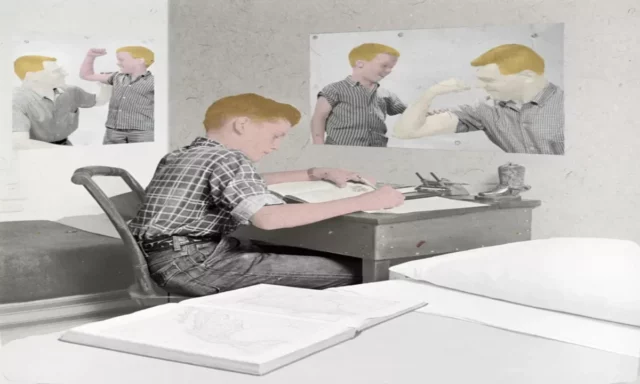When we think about our relationship with our bodies, it is often difficult to determine precisely where our satisfaction or dissatisfaction comes from. Imagine this scene; a girl tries on a cute dress, makes a twist and, with great satisfaction, straightens it. The adults around her echo her delight and tell her how pretty she is.
Later, she looks at her favorite books and sees skinny people and skinny animals embarking on exciting adventures, while her heavier counterparts are portrayed as slow or clumsy. Sometimes she finds that her own parents worry about their weight or appearance.
By the time she is a teenager, her parents may be concerned about the impact of influencers on her body image. But research indicates that, in reality, her perception of her bodies and her social acceptance will have been formed much earlier, in those early years.
When we think about our relationship with our bodies, it is often difficult to determine precisely where our satisfaction or dissatisfaction comes from. If we think about our childhood, we can remember a collection of comments or observations. None of them may seem hugely shocking on their own. And yet their cumulative effect can be surprisingly powerful.
Whether in the form of praise or criticism, the kind of attention to body shape can establish beliefs and insecurities that are difficult to shake. The consequences can be tremendously damaging, as studies show, with family attitudes and derogatory comments about weight linked to mental health problems or eating disorders. In addition, the broader stigmatization of overweight children has increased, which affects their self-esteem and, of course, their body image.
Given how early this awareness of body ideals begins, what can parents and caregivers do to help children feel confident and more caring toward others?
Body shame is not innate
Physical ideals differ enormously across time and across cultures: a quick glance at any painting by Peter Paul Rubens, or even the 29,500-year-old statuette known as the Venus of Willendorf, shows how exuberantly humans have embraced physical characteristics. curvaceous. But today, despite a growing body positivity movement that celebrates all shapes and sizes, the idea that a slim body is preferable remains pervasive on social media, in traditional media, on television, on the big screen and in advertising.
Awareness of body ideals begins early and reflects children’s experience of the world around them. In one study, children ages 3 to 5 were asked to choose a figure from a range of slim to large sizes, to represent a child with positive or negative characteristics.
For example, they were asked which children would be mean or nice, which children would be teased by others, and which children they would invite to the birthday party. Children tended to choose larger figures to represent negative characteristics.
Crucially, this bias was influenced by others: for example, their own mothers’ attitudes and beliefs about body shapes affected the outcome. Also, older children showed a stronger bias than younger children, again indicating that it was learned, not innate.
The findings “indicate that children’s social environments are important in the development of positive and negative attitudes toward weight”, the researchers conclude. “We see patterns in which children attribute positive characteristics to slimmer figures and negative characteristics to larger figures,” says Sian McLean, a psychology professor at La Trobe University in Melbourne, Australia, who specializes in body dissatisfaction. “They are developing that early, which is a concern because they potentially have an opportunity to internalize that perception, that being thinner is desirable and associated with social rewards”.
Another study showed that their parents’ attitude toward weight influenced children as young as 3 years old. Over time, children’s negative associations with large bodies and awareness of how to lose weight increased.
There is often an element of gender in these perceptions, with sons most affected by their fathers’ views and daughters by their mothers’ attitudes. While parents play an important role in shaping their children’s attitudes and views, it must be emphasized that they are far from the only influence young people are exposed to and can often have a positive effect which can counter messages from other sources.
The use of diets to control weight has been detected in girls as young as 5 years old, for example, and in that case, the main factors were exposure to the media, as well as conversations about appearance. But research shows that parents’ opinions do matter.

The danger of making fun of others
Many parents may be surprised to hear that their own insecurities, which may after all be completely involuntary and not something they wish to pass on, can have such an impact. But some family members also magnify this effect through derogatory comments.
In a study of the effects of teasing by family members on body dissatisfaction and eating disorders, 23% of participants reported being teased by a parent for their appearance, and 12% were teased about their appearance. teasing for being overweight, also by one of the parents.
More reported being teased by their fathers than by their mothers. Such parental teasing was a significant predictor of body dissatisfaction, as well as bulimic behaviors and depression, and also increased the odds that a sibling would tease them.
Maternal teasing was a significant predictor of depression. Being teased about appearance by a sibling had a similar negative impact on mental health and self-esteem, and increased the risk of eating disorders. The authors suggested that understanding a family history of teasing would help health care providers identify people at risk for “eating and body image disorders and poor psychological functioning.”
Other research in children ages 7 to 8 has shown that mothers’ comments about weight and body size have been linked to disordered eating behavior among their children. Similarly, girls “whose mothers, fathers, and friends encouraged them to lose weight and be thin” were more likely to endorse negative beliefs about others’ weight, known as “fat stereotypes”. This is especially alarming, given the rise in weight-related stigmatization and bullying.
Beyond family
There is a reason that parental influence is so strong. Rachel Rodgers, a psychologist at Northeastern University, says that when a father is concerned about his own body image, he is modeling behaviors that show “this is important.” “Even if they don’t mention the child’s physical appearance, they still act in a way that suggests to the child, ‘This is something I am worried about, this is something I’m worried about’, so the kids stick with it”.
In addition, many parents tend to comment on what children are eating, wearing or how they look, often with good intentions, and this can increase concerns about appearance and weight. The resulting “thin idealization” leads children to believe that their “social value depends on their physical appearance and that will lead them to invest in it in terms of their self-esteem as well as their time and energy,” says Rodgers. Of course, as the child gets older, their peers and the media tend to take on more of a role.
Unless they counteract each other, these influences can reinforce each other. “How media ideals are supported and supported by peers/friends was a more crucial factor than direct media exposure itself,” explains Jolien Trekels, a psychologist who studies body image at KU Leuven in Belgium, who conducted research on the role friends play in appearance ideals.
On a positive note, it may mean that young people are not only at the mercy of media ideals, but may collectively shape their own responses.
What to do about it?
Given how pervasive these messages are, what can parents do to counter them and instead encourage a more generous, positive, and empowering body image? First, as the evidence shows, how adults talk about the bodies around children matters. “We recommend that parents or educators not make comments about body image, even if they are positive”, says McLean.
Instead, parents should focus on what kids enjoy doing and what they’re interested in, putting “more value on who they are and their special skills and talents, and less on what they look like”, says Stephanie Damiano, who works at the charity Butterfly, which offers evidence-based support for eating disorders. This helps children to have a sense of satisfaction and self-esteem that is not tied to their appearance. They should also work on their own self-perception and self-esteem, as research shows how easy it is to pass on our insecurities.
Damiano advises parents to avoid talking about weight or constantly telling kids to eat healthier foods. “The more we focus on higher weight as a problem, or on certain foods as ‘bad’, the more guilt, shame and body dissatisfaction children are likely to feel.” Instead, parents may talk about exercise as being important to overall health and wellness, rather than a way to lose weight.

Families can also normalize the consumption of healthy foods, instead of openly talking about certain foods being bad. After all, we all love treats, so it seems counterproductive to teach children to feel guilty about having one. In fact, enjoying treats is known to be key to a healthy attitude toward weight. Watching TV cooking shows that feature healthy foods can also subtly encourage kids to eat those kinds of foods.
Family relationships can play an important positive role. One study showed that a good relationship between mothers and their adolescent children can reduce the negative effects of social media use on body dissatisfaction. Limiting children’s time on social media can reduce “appearance comparisons” and improve mental health. “How the parent gives meaning to what the child is seeing” is also very important, says Rodgers, as it can help the child decode what the images are really showing. And, of course, not all social networks are bad; they can also be a source of community and encouragement.
Parents may find it helpful to work as a team with schools
The Butterfly Body Bright program in Australia helps primary school children develop positive body image and lifestyle choices. In a pilot program, children’s body image was found to improve after a lesson.
Intervention programs that focus on building self-esteem have also been successful. Reflecting on these programs and their messages can even help parents examine their own ideas about weight and bodies, and let go of long-held harmful beliefs.
As for what you can do at home, an easy change might be to pause every time you’re about to compliment a child’s appearance and think of something else you like about them and want them to know. Instead of saying “I love your dress”, we can just smile and tell them how nice it is to see them and how fun it is to be around them.

For those who have experienced shifts in consciousness and know that more peace, joy, and love awaits in a better living environment. A bold shared vision. A living community and hub for innovation. A sustainable ecosystem for living and working. A model for the new future.
